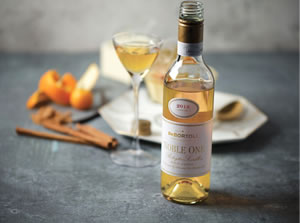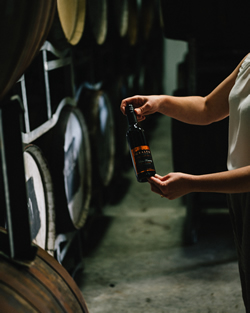By Christine Salins.

De Bortoli Noble One
Just as first impressions count, so too does the last impression. An amazing dessert at the end of a meal will likely be remembered for a long time. Put it together with an amazing dessert wine and you really do have fireworks.
In four decades of making dessert wines, De Bortoli has barely skipped a beat in producing its outstanding Noble One. It remains a benchmark for botrytis wines in Australia – wines where the fungus Botrytis cinerea, or “noble rot”, weaves its magic to create a luscious sweetness.
In all the years since De Bortoli’s first Botrytis Semillon in 1982, only two vintages have been missed due to too much rain, in 1989 and 2012. The process of making Noble One has only been tweaked slightly over the years, such as keeping a portion unoaked to add fruitfulness and freshness to the blend.
Darren De Bortoli says many consumers are fascinated to learn that there is no sugar added in Noble One – the sweetness is all natural and comes solely from the “noble rot”.

Gralyn Pedro Xeminez
By the 1990s, Yalumba was making botrytis wines out of Riesling, Semillon, Sauvignon Blanc and even Chardonnay. When it realized that the flavours of these botrytis wines – apricots, lavender, spice etc – were similar to the flavours in its Viognier, it figured Viognier might have a synergy with botrytis.
“We’ve found it absolutely to be the case,” says winemaker Louisa Rose. “I don’t know where the Viognier stops and the botrytis starts in terms of the flavour. It’s got that lovely freshness and concentration as well as a lovely sweetness.”
A few months ago, we profiled Gralyn Estate, one of only a handful of Western Australian wineries to specialise in fortified wines. These also make a wonderful finale for a special meal.
Owners and winemakers Scott and Annette Baxter say more and more Aussies are rediscovering fortified wines. Playing to the trend, they have a range of exotic labels including a White Chocolate Fortified and a newly released Pedro Ximénez, the latter more than 10 years in the making.
The PX was made from vines that are more than a century old, but Gralyn’s focus is squarely on the future. “We don’t see fortified wines as purely a historic wine style, it’s very much the present and future for us here in Margaret River,” says Annette.

alumba FSW Botrytis Viognier
De Bortoli 2018 Noble One, $36 (375ml): This blend of the very best parcels of botrytised Semillon, matured in French oak, is a rich, complex, harmonious balance of sweetness and acidity, melding stonefruit and citrus characters with a touch of honey and vanilla. A match not just for dessert, it pairs with cheese and even some savoury dishes, but Darren De Bortoli’s favourite way to enjoy it is simply with fresh apples, oranges and/or pears. Also available in a 750ml bottle for $76.
Yalumba 2020 FSW Botrytis Viognier, $30 (375ml): Autumn in South Australia’s Wrattonbully region – with dewy mornings, soft mists and the warm sun shining on ripe grapes – are perfect for botrytis, amplifying the rich apricot aromas and flavours of Viognier. The result is an almost marmalade-like toastiness, hints of spice and a long, silky finish. Winemaker Louisa Rose recommends enjoying it with tarte Tatin and cinnamon ice cream, baklava or vegan raspberry cheesecake.
Gralyn Estate Pedro Ximénez, $65 (375ml): I fell in love with this rich, velvety style of Sherry while travelling in Spain and I’m mighty impressed with how closely this Margaret River wine comes to the ones I had there. It’s a gorgeous dark golden/brown colour with enticing aromas of nutty caramel, and rich luscious raisin, fig and toffee notes. With an average barrel age of 10+ years and matured in old brandy casks, it finishes long and smooth. You’re in for a treat.
Gralyn Estate White Chocolate Fortified, $65 (750ml): How do you like your chocolate? With a drop of port? Why not enjoy both together? This limited release is a fortified wine made in the style of port. Chardonnay and Semillon grapes are infused with chocolate during vinification, resulting in a lush, nectar-like blend of stonefruit, vanilla and chocolate that tastes best when served slightly chilled. You could, of course, enjoy it with chocolate, but equally it goes beautifully with fruit desserts.



